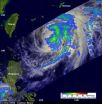Mosquitoes fly in rain thanks to low mass
2012-06-05
(Press-News.org) The mosquito is possibly summer's biggest nuisance. Sprays, pesticides, citronella candles, bug zappers — nothing seems to totally deter the blood-sucking insect. And neither can rain apparently.
Even though a single raindrop can weigh 50 times more than a mosquito, the insect is still able to fly through a downpour.
Georgia Tech researchers used high-speed videography to determine how this is possible. They found the mosquito's strong exoskeleton and low mass render it impervious to falling raindrops.
The research team, led by Assistant Professor of Mechanical Engineering David Hu and his doctoral student Andrew Dickerson, found that mosquitoes receive low impact forces from raindrops because the mass of mosquitoes causes raindrops to lose little momentum upon impact. The results of the research will appear in the June 4 issue of the Proceedings of the National Academy of Sciences of the United States of America.
"The most surprising part of this project was seeing the robustness this small flyer has in the rain," Dickerson said. "If you were to scale up the impact to human size, we would not survive. It would be like standing in the road and getting hit by a car."
What the researchers learned about mosquito flight could be used to enhance the design and features of micro-airborne vehicles, which are increasingly being used by law enforcement and the military in surveillance and search-and-rescue operations.
To study how mosquitoes fly in the rain, the research team constructed a flight arena consisting of a small acrylic cage covered with mesh to contain the mosquitoes but permit entry of water drops. They used a water jet to simulate rain stream velocity and observed six mosquitoes flying into the stream. All the mosquitoes survived the collision.
"The collision force must equal the resistance applied by the insect," Hu said. "Mosquitoes don't resist at all, but simply go with the flow."
The team also filmed free-flying mosquitoes that were subjected to rain drops. They found that upon impact the mosquito is adhered to the front of the drop for up to 20 body lengths.
"To survive, the mosquito must eventually separate from the front of the drop," Hu said. "The mosquito accomplishes this by using its long legs and wings, whose drag forces act to rotate the mosquito off the point of contact. This is necessary, otherwise the mosquito will be thrown into the ground at the speed of a falling raindrop."
INFORMATION: END
ELSE PRESS RELEASES FROM THIS DATE:
2012-06-05
WEST LAFAYETTE, Ind. - A new Purdue University-developed process for creating biofuels has shown potential to be cost-effective for production scale, opening the door for moving beyond the laboratory setting.
A Purdue economic analysis shows that the cost of the thermo-chemical H2Bioil method is competitive when crude oil is about $100 per barrel when using certain energy methods to create hydrogen needed for the process. If a federal carbon tax were implemented, the biofuel would become even more economical.
H2Bioil is created when biomass, such as switchgrass or corn ...
2012-06-05
As voters increasingly rely on websites of presidential primary candidates for news, they run a risk because candidates' online attacks are not vetted through traditional "watchdog journalists" and other gatekeepers to determine accuracy or fairness, according to a study by Baylor University researchers.
"The primary danger is that constituents often use this one-sided information to decide how to vote," said Mia Moody, Ph.D., study co-author and an assistant professor of journalism, public relations and new media in Baylor's College of Arts & Sciences.
The study — "Not ...
2012-06-05
AUDIO:
Drugs that are used to treat Type 2 diabetes also can contribute to unwanted side effects. But now, working with mice, researchers, led by scientists at Washington University School of...
Click here for more information.
Drugs for type 2 diabetes can contribute to weight gain, bone fractures and cardiovascular problems, but in mice, an investigational drug appears to improve insulin sensitivity without those troublesome side effects, researchers at Washington University ...
2012-06-05
Over the weekend of June 2 and 3, Typhoon Mawar skirted the east coast of the Philippines bringing heavy surf, heavy rainfall and gusty winds that led to several missing and injured people. NASA's TRMM satellite and Aqua satellite showed heavy rainfall and cloud extent of the storm.
On June 1, Mawar (known as Ambo in the Philippines) had maximum sustained winds near 45 knots and it was about 245 miles east-northeast of Manila, Philippines. On that day, as Mawar continued north, some warnings were posted for the Philippines: Public storm warning signal #1 was up in the ...
2012-06-05
ANN ARBOR, Mich.—Religious practices that strongly control female sexuality are more successful at promoting certainty about paternity, according to a study published in the current issue of the Proceedings of the National Academy of Sciences.
The study analyzed genetic data on 1,706 father-son pairs in a traditional African population—the Dogon people of Mali, West Africa—in which Islam, two types of Christianity, and an indigenous, monotheistic religion are practiced in the same families and villages.
"We found that the indigenous religion allows males to achieve ...
2012-06-05
DALLAS – June 4, 2012 – UT Southwestern Medical Center researchers have taken a major step toward understanding the cellular clock, mapping for the first time the atomic-level architecture of a key component of the timekeeper that governs the body's daily rhythms.
The daily, or circadian, cycles guided by the body's clocks affect our ability to get a good night's sleep, how fast we recover from jet lag, and even the best time to give cancer treatments, said Dr. Joseph Takahashi, senior author of the Science study published online and a pioneer in the study of circadian ...
2012-06-05
The RHESSI (Ramaty High Energy Solar Spectroscopic Imager) satellite focuses on the highest energy x-rays and gamma-rays produced by the sun, helping to observe solar flares of all shapes and sizes. The satellite is pointed toward the sun, and constantly in rotation, which provides a serendipitous bit of side research: by monitoring the limb of the sun on its four second rotation cycle, RHESSI's Solar Aspect System (SAS) has produced ten years worth of precise measurements of the sun's diameter. This has already provided scientists with one of the most accurate measurements ...
2012-06-05
When Venus transits the sun on June 5th and 6th, an armada of spacecraft and ground-based telescopes will be on the lookout for something elusive and, until recently, unexpected: The Arc of Venus.
"I was flabbergasted when I first saw it during the 2004 transit," recalls astronomy professor Jay Pasachoff of Williams College. "A bright, glowing rim appeared around the edge of Venus soon after it began to move into the sun."
For a brief instant, the planet had turned into a "ring of fire."
Researchers now understand what happened. Backlit by the sun, Venus's atmosphere ...
2012-06-05
Half of adults over age 65 made at least one emergency department (ED) visit in the last month of life, in a study led by a physician at the San Francisco VA Medical Center (SFVAMC) and UCSF.
Three quarters of ED visits led to hospital admissions, and more than two-thirds of those admitted to the hospital died there.
In contrast, the 10 percent of study subjects who had enrolled in hospice care at least one month before death were much less likely to have made an ED visit or died in the hospital.
"For too many older Americans, the emergency department is a conduit ...
2012-06-05
Boulder, Colo., USA – New Lithosphere science posted online 4 June 2012 includes a study of the Valles Marineris fault zone, Mars, and asks why such a trough system occurs there, when such structures on Earth are mainly associated with plate tectonics. Other papers discuss landslides in the Pyrenees; first evidence of a "missing" Cretaceous arc assemblage in the Iraqi segment of the Zagros orogenic belt; and new information on the age of the Okanagan Valley shear zone, Canada.
Abstracts are online at http://lithosphere.gsapubs.org/content/early/recent. Representatives ...
LAST 30 PRESS RELEASES:
[Press-News.org] Mosquitoes fly in rain thanks to low mass





